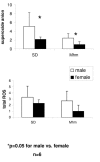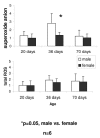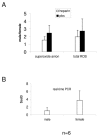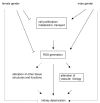Faster rates of post-puberty kidney deterioration in males is correlated with elevated oxidative stress in males vs females at early puberty
- PMID: 17620128
- PMCID: PMC1934371
- DOI: 10.1186/1471-2164-8-221
Faster rates of post-puberty kidney deterioration in males is correlated with elevated oxidative stress in males vs females at early puberty
Abstract
Background: Post-puberty deterioration of kidneys is more rapid in males than in females. To reveal the underlying molecular mechanisms for this difference, we analyzed gender-dependent gene expression in kidneys of three groups of 36 day-old rats.
Results: The number of genes exhibiting gender-dependent expression was highly influenced by the genetic background of the rat group examined. 373, 288 and 79 genes showed differential gene expression between males and females (p = 0.001) in US, Mhm and Mhm*BN rats, respectively. Of all gender dependently expressed genes, only 39 genes were differentially expressed in all tested groups and the direction of expression change was the same for those genes for all groups. The gene expression profile suggests higher metabolic and transport activities, enhanced cell proliferation, elevated oxidative stress, and altered vascular biology in males. Furthermore, elevated levels of superoxide anion (two- to three-fold) in males compared to females were detected at early puberty, but neither at pre-puberty nor at late puberty/early adulthood.
Conclusion: Our data suggest that early puberty, with gender-related elevation in oxidative stress in males, is a key compromising factor on kidneys in males.
Figures






Similar articles
-
D-Serine exposure resulted in gene expression changes indicative of activation of fibrogenic pathways and down-regulation of energy metabolism and oxidative stress response.Toxicology. 2008 Jan 14;243(1-2):177-92. doi: 10.1016/j.tox.2007.10.009. Epub 2007 Oct 23. Toxicology. 2008. PMID: 18061331
-
Differential expression of immunoregulatory genes in male and female Norway rats following infection with Seoul virus.J Med Virol. 2004 Sep;74(1):180-90. doi: 10.1002/jmv.20163. J Med Virol. 2004. PMID: 15258986
-
Differential sensitivity of male and female mouse embryos to oxidative induced heat-stress is mediated by glucose-6-phosphate dehydrogenase gene expression.Mol Reprod Dev. 2005 Dec;72(4):502-10. doi: 10.1002/mrd.20366. Mol Reprod Dev. 2005. PMID: 16149081
-
Sex differences in oxidative stress and the impact on blood pressure control and cardiovascular disease.Clin Exp Pharmacol Physiol. 2007 Sep;34(9):938-45. doi: 10.1111/j.1440-1681.2007.04643.x. Clin Exp Pharmacol Physiol. 2007. PMID: 17645644 Review.
-
Molecular basis of pubertal abnormalities.Obstet Gynecol Clin North Am. 2003 Jun;30(2):261-77. doi: 10.1016/s0889-8545(03)00032-9. Obstet Gynecol Clin North Am. 2003. PMID: 12836719 Review.
Cited by
-
Mutant polycystin-2 induces proliferation in primary rat tubular epithelial cells in a STAT-1/p21-independent fashion accompanied instead by alterations in expression of p57KIP2 and Cdk2.BMC Nephrol. 2008 Aug 25;9:10. doi: 10.1186/1471-2369-9-10. BMC Nephrol. 2008. PMID: 18721488 Free PMC article.
-
Dietary Flavonoid Intake and Anemia Risk in Children and Adolescents: Insights from National Health and Nutrition Examination Survey.Antioxidants (Basel). 2025 Mar 27;14(4):395. doi: 10.3390/antiox14040395. Antioxidants (Basel). 2025. PMID: 40298649 Free PMC article.
-
Guidelines for sex-specific considerations to improve rigor in renal research and how we got there.Am J Physiol Renal Physiol. 2025 Feb 1;328(2):F204-F217. doi: 10.1152/ajprenal.00136.2024. Epub 2024 Dec 20. Am J Physiol Renal Physiol. 2025. PMID: 39705719 Free PMC article. Review.
References
-
- Gretz N, Zeier M, Geberth S, Strauch M, Ritz E. Is gender a determinant for evolution of renal failure? A study in autosomal dominant polycystic kidney disease. Am J Kidney Dis. 1989;14:178–183. - PubMed
MeSH terms
Substances
Associated data
- Actions
LinkOut - more resources
Full Text Sources
Medical
Molecular Biology Databases

